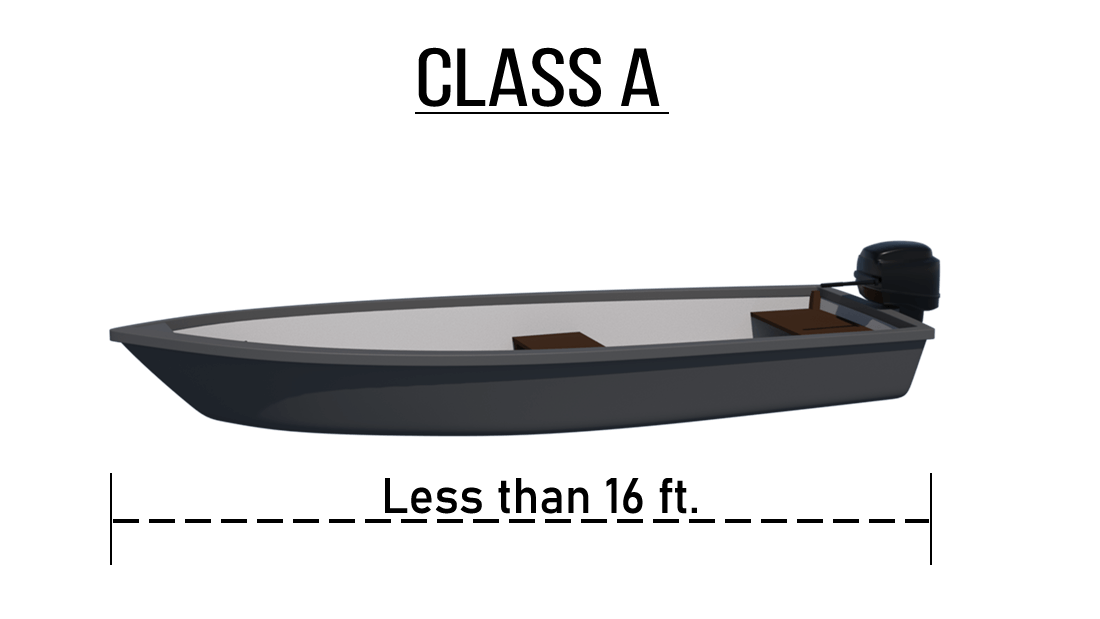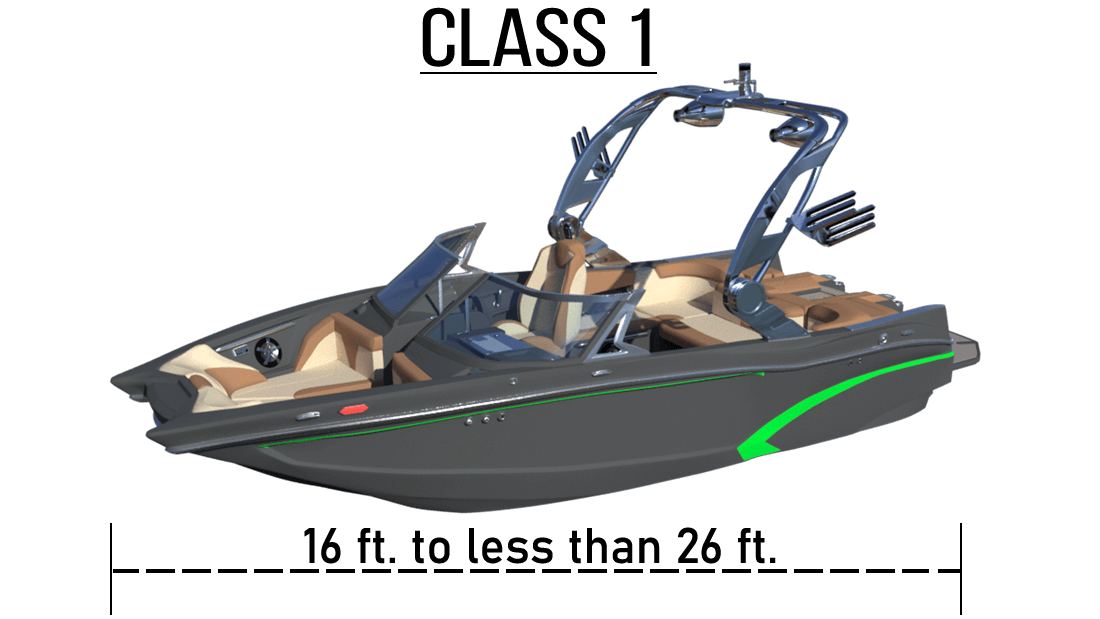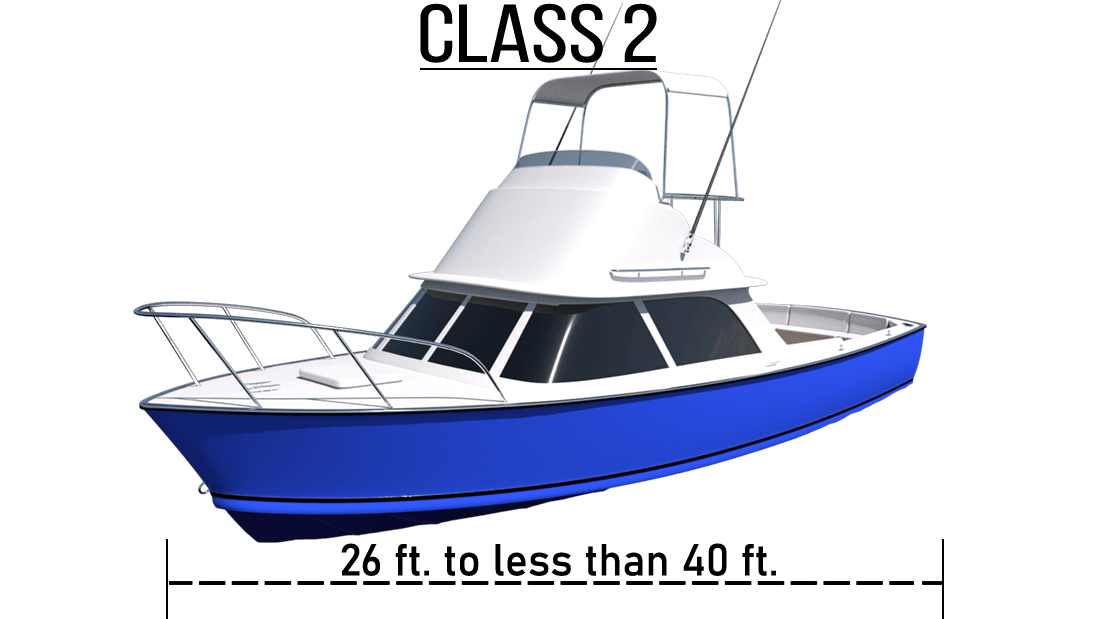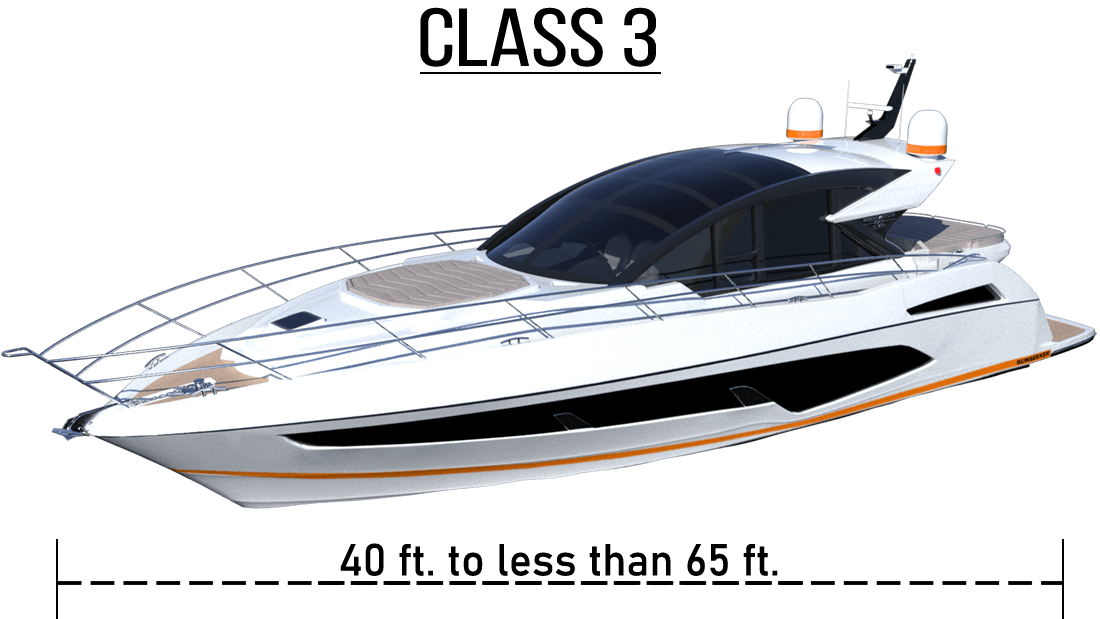NYS Required Boat Safety Equipment

NYS law requires that you have specific safety equipment on board depending on the class of your boat.
Unless otherwise noted, all required equipment must be:
- Coast Guard-approved
- Of the proper type and/or size
- Kept in good, serviceable condition
- Appropriate for the intended activity
- Readily accessible

Vessels Less than 16'

Life Jackets
One Type I, II, III or V Coast Guard-approved life jacket must be carried for each person on board.
Note: An inflatable life jacket must be worn to be considered readily accessible.
PFD's must be worn by anyone under age 12.
Boating Safety Certificate
As of January 1, 2020, New York law will require all boat operators to carry the New York boating safety certificate. This law will be phased in over six years.
Fire Extinguisher
One Type B-I Coast Guard-approved fire extinguisher must be carried.
Backfire Flame Arrestor
A Coast Guard-approved backfire flame arrestor is required for inboard gasoline motors that are not exposed to the atmosphere above the gunwale level.
Muffling System
An effective muffling system is required for the exhaust of each internal combustion engine.
Ventilation System
All motorboats or motor vessels, except open boats made after 1940 and using gasoline as a fuel must have at least two ventilator ducts fitted with cowls or their equivalent for the efficient removal of explosive or flammable gases from all engine and fuel tank compartment bilges.
Boats built after July 31, 1990, that have a gasoline engine for electrical generation, mechanical power or propulsion must be equipped with an operable ventilation system.
Sound Signaling Devices
A motorboat less than 39 feet must be able to provide a means of making an efficient sound signal, but is not required to carry a whistle or bell. Mouth whistle acceptable.
Visual Distress Signals (Coastal Waters Only)
Boats less than 16 feet are only required between sunset and sunrise to carry aboard devices that are suitable for night use. Flashlight acceptable.
Navigation Lights
Boats less than 16 feet are only required to carry aboard devices that are suitable for night use between sunset and sunrise.
Anchor & line
Required if mechanically propelled.
Capacity Plate
Required
Muffled Exhaust
Required
Noise level compliance
90 dB Stationary, 75 db underway for all vessel with above water exhaust.
Valid Registration
Required if mechanically propelled
Vessels 16' to Less than 26'(8m)

Life jackets
One Type I, II, III or V Coast Guard-approved wearable life jacket must be carried for each person aboard. Life jackets must be readily accessible and of an appropriate size for the intended wearer.
In addition, the vessel must carry an approved Type IV throw able device, which should be immediately available.
Note: An inflatable life jacket must be worn to be considered readily accessible.
PFD's must be worn by anyone under age 12.
Boating Safety Certificate
As of January 1, 2020, New York law will require all boat operators to carry the New York boating safety certificate. This law will be phased in over six years.
Fire Extinguisher
One Type B-I Coast Guard-approved fire extinguisher must be carried.
Backfire Flame Arrestor
A Coast Guard-approved backfire flame arrestor is required for inboard gasoline motors that are not exposed to the atmosphere above the gunwale level.
Muffling System
An effective muffling system is required for the exhaust of each internal combustion engine. Unmodified outboards usually meet legal requirements.
Ventilation System
All motorboats or motor vessels, except open boats made after 1940 and using gasoline as a fuel must have at least two ventilator ducts fitted with cowls or their equivalent for the efficient removal of explosive or flammable gases from all engine and fuel tank compartment bilges.
Boats built after July 31, 1990, that have a gasoline engine for electrical generation, mechanical power or propulsion must be equipped with an operable ventilation system.
Sound Signaling Devices
A motorboat less than 39 feet must be able to provide a means of making an efficient sound signal, but is not required to carry a whistle or bell. Mouth whistle acceptable.
Visual Distress Signals (Coastal Waters Only)
All boats 16 feet or more in length must carry devices aboard at all times. Boaters must carry either of the following devices that are suitable for day or night use:
-
Hand red Flare, distress signals
-
Floating orange smoke distress signals (day)
-
Pistol projected parachute red flare distress signals
-
Hand-held rocket-propelled parachute red
-
Hand-held orange smoke distress signals (day only)
-
Distress signal for boats, red aerial pyrotechnic flare
-
Orange flag (day)
-
Electric distress light for boat (night)
Navigation Lights
Navigation lights must be kept in serviceable condition and displayed between sunset and sunrise and at times of restricted visibility.
Anchor & line
Required if mechanically propelled.
Capacity Plate
Required
Muffled Exhaust
Required
Noise level compliance
90 dB Stationary, 75 db underway for all vessel with above water exhaust.
Valid Registration
Required if mechanically propelled
Vessels 26' to Less than 40'(8m)

Life jackets
One Type I, II, III or V Coast Guard-approved wearable life jacket must be carried for each person aboard. Life jackets must be readily accessible and properly fit the intended wearer.
Note: An inflatable life jacket must be worn to be considered readily accessible.
In addition, the vessel must carry an approved Type IV throw able device, which should be immediately available.
PFD's must be worn by anyone under age 12.
Boating Safety Certificate
As of January 1, 2020, New York law will require all boat operators to carry the New York boating safety certificate. This law will be phased in over six years.
Fire Extinguisher
Two Type B-I or one Type B-II Coast Guard-approved fire extinguishers must be carried
With a fixed system in the machinery space, one Type B-I fire extinguisher must be carried.
Backfire Flame Arrestor
A Coast Guard-approved backfire flame arrestor is required for inboard gasoline motors that are not exposed to the atmosphere above the gunwale level.
Muffling System
An effective muffling system is required for the exhaust of each internal combustion engine. Unmodified outboards usually meet legal requirements.
Ventilation System
All motorboats or motor vessels, except open boats made after 1940 and using gasoline as a fuel must have at least two ventilator ducts fitted with cowls or their equivalent for the efficient removal of explosive or flammable gases from all engine and fuel tank compartment bilges.
Boats built after July 31, 1990, that have a gasoline engine for electrical generation, mechanical power or propulsion must be equipped with an operable ventilation system.
Sound Signaling Devices
A motorboat less than 39 feet must be able to provide a means of making an efficient sound signal, but is not required to carry a whistle or bell. Mouth whistle acceptable.
Vessels 39 feet 4 inches (12 meters) or more in length are required to carry a whistle and a bell.
Visual Distress Signals (Coastal Waters Only)
All boats 16 feet or more in length must carry devices aboard at all times. Boaters must carry either of the following devices that are suitable for day or night use:
-
Hand red Flare, distress signals
-
Floating orange smoke distress signals (day)
-
Pistol projected parachute red flare distress signals
-
Hand-held rocket-propelled parachute red
-
Hand-held orange smoke distress signals (day only)
-
Distress signal for boats, red aerial pyrotechnic flare
-
Orange flag (day)
-
Electric distress light for boat (night)
Navigation Lights
Navigation lights must be kept in serviceable condition and displayed between sunset and sunrise and at times of restricted visibility.
Anchor & line
Required if mechanically propelled.
Muffled Exhaust
Required
Noise level compliance
90 dB Stationary, 75 db underway for all vessel with above water exhaust.
Valid Registration
Required if mechanically propelled
Vessels 40' to Less than 65'(8m)

Life jackets
One Type I, II, III or V Coast Guard-approved wearable life jacket must be carried for each person aboard. Life jackets must be readily accessible and properly fit the intended wearer.
Note: An inflatable life jacket must be worn to be considered readily accessible.
In addition, the vessel must carry an approved Type IV throw able device, which should be immediately available.
PFD's must be worn by anyone under age 12.
Boating Safety Certificate
As of January 1, 2020, New York law will require all boat operators to carry the New York boating safety certificate. This law will be phased in over six years.
Fire Extinguisher
Three B-I or
One B-I and One B-2 Coast Guard-approved fire extinguisher
With a fixed system in the machinery space, two Type B-I or one Type B-II extinguisher must be carried.
Backfire Flame Arrestor
A Coast Guard-approved backfire flame arrestor is required for inboard gasoline motors that are not exposed to the atmosphere above the gunwale level.
Muffling System
An effective muffling system is required for the exhaust of each internal combustion engine. Unmodified outboards usually meet legal requirements.
Ventilation System
All motorboats or motor vessels, except open boats made after 1940 and using gasoline as a fuel must have at least two ventilator ducts fitted with cowls or their equivalent for the efficient removal of explosive or flammable gases from all engine and fuel tank compartment bilges. Boats built after July 31, 1990, that have a gasoline engine for electrical generation, mechanical power or propulsion must be equipped with an operable ventilation system.
Sound Signaling Devices
Vessels 39 feet 4 inches (12 meters) or more in length are required to carry a whistle and a bell.
Visual Distress Signals (Coastal Waters Only)
All boats 16 feet or more in length must carry devices aboard at all times. Boaters must carry either of the following devices that are suitable for day or night use:
-
Hand red Flare, distress signals
-
Floating orange smoke distress signals (day)
-
Pistol projected parachute red flare distress signals
-
Hand-held rocket-propelled parachute red
-
Hand-held orange smoke distress signals (day only)
-
Distress signal for boats, red aerial pyrotechnic flare
-
Orange flag (day)
-
Electric distress light for boat (night)
Navigation Lights
Navigation lights must be kept in serviceable condition and displayed between sunset and sunrise and at times of restricted visibility.
Anchor & line
Required if mechanically propelled.
Muffled Exhaust
Required
Noise level compliance
90 dB Stationary, 75 db underway for all vessel with above water exhaust.
Valid Registration
Required if mechanically propelled
New York State requires anyone operating a motorized vessel to complete a boating safety course. All motorboat operators—regardless of age—must hold an approved NYS boating license to operate legally, helping ensure safer, more responsible boating on state waters.